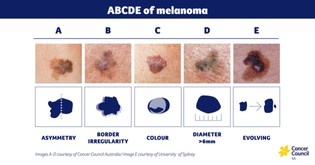With two in three Australians being diagnosed with some form of skin cancer before the age of 70, looking after your body’s largest organ—your skin—is important and should be part of every Aussie’s regular self-care routine.
The change of season and drop in temperature, often mean that the sun protection and skin cancer aren’t front of mind like they are in summer. But now is an opportune time to get to know your skin. Becoming familiar with what’s normal for you and regularly self-checking your body for signs of change is the best way to catch skin cancer early and in turn gives you the best chance of successful treatment.
How to check
Everyone can check their own skin and with a bit of practice, most people can check their whole body in 15 minutes. You’ll need to fully undress to examine your skin.
In a well-lit room, use a full-length mirror and a hand-held mirror to check all your skin. It also helps to have someone assist you with those difficult-to-see places. If you have a partner or someone you feel comfortable with, ask them to help you. A little bit of ‘I’ll show you mine if you show me yours’ can go a long way in catching any changes early or identifying new spots.
What to look out for
Keep an eye on spots that look different to others on your body, spots that have changed in size, shape, colour or texture, and sores that itch, bleed, or don’t heal. If you notice any of these signs, see your doctor and seek their expert opinion.
There are three common types of skin cancers—basal cell carcinoma, squamous cell carcinoma, and melanoma—and they can all look quite different.
- Basal cell carcinoma (BCC) often appears as a pearly or shiny-coloured lump, or a slightly scaly area that is either pale fleshy tone, bright pink, or darker red in colour. You may notice this type of spot can bleed and become inflamed and ulcerate, and some seem to partially heal then flare up again. BCC grows slowly over months or years and rarely spreads to other parts of the body but the earlier a BCC is diagnosed, the easier it is to treat.
- Squamous cell carcinoma (SCC) appears as either a thickened red, scaly or crusted spot, or a rapidly-growing lump. You may notice this type of spot bleeds and becomes inflamed and is often tender to touch. SCC tends to grow quickly over several weeks or months. If left untreated, SCC can spread to other parts of the body and this is known as invasive SCC. SCC on the lips and ears is more likely to spread.
- Melanoma appears as a new spot or existing spot that has changed in colour, shape or size over several weeks or months. It can have either a flat or raised surface and may have an irregular border. Melanomas can also be more than one colour. Although melanoma is a less common type of skin cancer, it is considered the most serious because it grows quickly and is more likely to spread to other parts of the body, such as the lymph nodes, lungs, liver, brain and bones, especially if not found early. The earlier melanoma is found, the more successful treatment is likely to be.
The ABCDE guide has been developed to describe common characteristics of melanoma to help you know what to look for.
SunSmart_Infograph_ABCDE of Melanoma
Use the guide to examine your spots, keeping in mind that suspicious spots do not need to carry all characteristics. Don’t delay making an appointment with your doctor if you notice new or changing spots or there’s anything you’re just not sure about.
Want to know how to check your skin? Read more about finding skin cancer early here.
